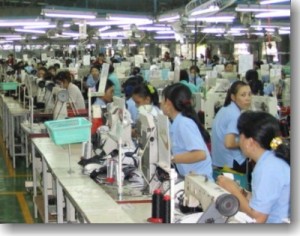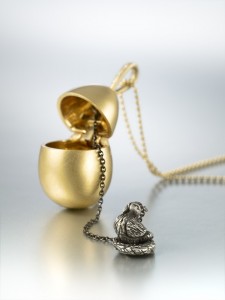Those of you who haven’t been with me since I began this blog in 2007 might not know that I initially went into the jewelry business with a partner. She was a diamond wholesaler for 26 years. Our joint business was something fun on the side for her. A side salad, as gorgeous food-blogger Tina would say.
My partner, who died in 2006, was a great saleswoman. When she was making a sale, she would say, “I’m going to give you a little education” and explain to people why a particular stone or piece of finished jewelry cost what it did. I enjoyed her lectures. They really were helpful. Now I’m going to give you an education.
I’ve done this before. Feel free to read or re-read the post about the costs of producing fine jewelry I wrote earlier this year. I also did a post on the rising price of gold, comparing the cost of the same gold chain purchased at different times. But that information about fine jewelry leaves people with several burning questions.* The first burning question is:
“Why don’t you make cheap stuff?”
First of all, bitches, we are elegant people on this blog, so we don’t say “cheap.” We say “inexpensive” or our super-secret code: “Jimmy Choo for H&M.” And, as I’ve said, I would love to do inexpensive jewelry for the likes of H&M. But it costs money to manufacture cheap inexpensive products because even if you use inexpensive materials, you still have to pay for labor. In other words, the retail price isn’t based on the cost of materials alone. Think about it! Canvas and paint cost very little compared to gold and diamonds, but we don’t price a Picasso by doubling the cost of the canvas and paint. I don’t normally compare myself to Picasso — just because I don’t have as many girlfriends as he did — but like his paintings, my jewelry is worth more than a simple multiple of the cost of materials I use.
U.S. labor is expensive. Labor, for me, includes the wax carvers, mold makers, metal casters, goldsmiths and stone setters whom I employ, all of whom expect to get paid.** If I waste expensive labor on inexpensive material, I wind up with a customer who wrinkles her nose and bitches: “You’re charging THIS? For SILVER/PLATED BRASS/PLASTIC/RHINESTONES?!” (Have you said that? Be honest. I bet you have: “This handbag is CANVAS?”) I don’t like that experience, which leads to burning question #2:
Why is U.S. labor expensive?
U.S. labor is expensive because the U.S. has a high standard of living. People in ANY job — including you, unless you’ve taken a vow of poverty — want wages that allow them to maintain that high standard of living. Luckily for you bargain hunters, other countries don’t have such a high standard of living. People will work for very little. To be blunt and use the bad word: Cheap goods are made by cheap non-U.S. labor.***
Here’s a good example of the difference in labor costs. I designed and manufactured a silver ring in the U.S. for $40.**** The price of silver is the same everywhere. As I’m writing this post, it’s about $17 an ounce. I sampled that silver ring at a factory in Asia and it cost $4, which leads to burning question #3:
So why don’t you just make all your jewelry in Asia?
Lower quality calls for higher quantity. A factory would go out of business fast if it let me order one or even 10 inexpensive rings for $4 each, so the minimum order is 100 of one style. If I want to do ten inexpensive ring styles, I’ve suddenly got 1,000 pieces in my inventory and I’ve spent $4,000. What am I going to do with all those rings? I need a big store to sell them. I can’t spend $4,000 on spec and hope for the best! What if I try to get H&M or Target interested, but they don’t want these particular styles? What if they want white skull rings and I’m stuck with 100 black skull rings? Trust me, the minute one of those retailers gives me a big order, I’ll spend the $4,000 and more to meet the demand and all of you will be able to run to the store and buy a lesser version of my signature look for under $50. Until that order comes in, I will be making most of my pieces one or two at a time, here in New York, using high-quality U.S. labor on raw material that is worth the investment.*****
Speaking of quality, another cost of manufacturing overseas is travel. As I just pointed out, my U.S. manufacturers are top quality. Also, it’s easy for me to drop by their places and see how my jewelry is shaping up. If I there’s anything I don’t like, I don’t take the piece and tell them to keep working on it. To do quality control overseas, I’d need to be on site, even if the overseas factory is excellent. If I stay in the U.S. and the overseas factory sends the product after eight weeks of work and transportation and THEN I find out it wasn’t done the way I wanted it to be done, sending it back is a big deal. I might not get the product back for another eight weeks. The following is a rhetorical question, not a burning question: Do I want to spend the money to travel to Asia and live there for months in order to supervise the production of thousands of pieces of jewelry for which I have no retail outlet? NO THANKS!
The situation I’m in is a classic small-business conundrum. I could sell more if I charged less, but I can’t charge less till I sell more. This applies to most small businesses, whether the product is software or apparel. There are some exceptions, such as jewelers who sit on their floor or at their kitchen tables, stringing their own beads, twisting their own wires, setting their own stones. That cuts down on the labor that needs to be hired, but sometimes the designer undercharges for her own labor. If she’s not doing anything else to earn money during those hours spent doing the work herself, she ought to be compensated properly. In addition to the cost of materials, she has to pay for rent, packaging and any marketing of the product she has to do. Also, if her pieces do well and she has to ramp up production to meet demand, how is she going to do it with her bare hands? That way of manufacturing is putting off the inevitable if growth is what you want. I have manufacturing connections and am ready to expand. I think it’s a lot harder to deliver a large order in a few months time if you’ve been sitting at your kitchen table and have no manufacturing contacts. People go out of business in that scenario.
There’s more to be said on this topic but I’ll stop here for now. The asterisks sprinkled throughout this post are explained below.
——————————————————————————————————-
FOOTNOTES
*I can help you with burning QUESTIONS but if you have a burning SENSATION, go to the free clinic.
**Everyone has to get paid. No one can — or should — work for free. Please note that I would never suggest that any of you work for free. “Free” includes working for experience, portfolio-building or product. In my experience, whether I was doing the work or having someone do the work for me, the situation turns out poorly. Cash or, for interns, college credit are the only payment options I will ever recommend.
***Consumer demand for inexpensive apparel has pushed clothing production out of the U.S. There are exceptions to the rule, such as American Apparel, but the U.S.-made clothing product is so rare now that the company made that its whole selling point. Nearly all clothing production is overseas; New York’s Garment Center has shrunk drastically.
****That’s what it cost ME. Obviously, my wholesale price would be higher and a retailer’s price would be significantly higher than that.
*****One exception is the swear rings. Because they use a lot of metal and come in sets of four, the factory reduced its minimum and made 50 sets instead of 100. You can tell from the price. These rings are solid sterling silver. If I made them in the U.S., they’d have to retail for about $1,000. I know this because I made the samples here for the overseas factory to copy. My only other pieces made overseas are the $125 silver squirrel necklace and $50 silver Teeny Genie and Little Woolf necklaces. I made the first dozen here (those U.S.-made pieces are recently sold out in all three styles), then I made 100 of each overseas. I figured they were small enough, inexpensive enough and popular enough that I could take the chance. I was selling the original U.S.-made ones at a loss.
UPDATED AUGUST 2010 TO ADD: I’m trying to add new swear rings to my line: OMG, LOLZ and NYC. I need to make them overseas for the reasons cited above. Through September 12, 2010, I’m raising money on Kickstarter by accepting pre-orders on the rings. I originally planned to do just OMG and LOLZ, and I raised $7,000, covering the factory minimum run. Due to popular demand, I added the NYC style, but now I need an additional $3,000 for a total of $10,000. I spoke to the factory owners and they were inflexible when it came to the minimum. So please go to Kickstarter, pre-order and make these designs possible! They won’t be delivered till close to the December holidays, most likely, so consider getting them as a holiday gift.
UPDATED AGAIN TO ADD: The Kickstarter campaign above was successful! Thank you. To learn more about the real costs of doing business, read my other “Get Smart” posts, with topics including quality, quantity, custom work and metal prices. Everything except the metal applies to a wide range of small businesses, not just jewelry! To read more about the agony and ecstasy of having a small business, read my Huffington Post article, which grew out of my “Get Smart” series.




Oh what a wonderful post. And it’s not like people would complain if you were selling nice footballs. But I believe you have covered THAT topic before.
And oh! My anti-spam word is Matilda! I love that book/movie.
Fantastic post; thank you.
Everything about this post is BRILLIANT!! Beautifully said!!! *applauds*
Conundrum is Right! I have really appreciate this post. Kudos for always being so forthcoming and honest! Afterall that is how business was meant to be…I think so anyway! Awesome installment!
thank you for writing this!!! i find myself in a defensive position all the time with customers, and i make everything by hand. they just don’t get it.
would you mind if i linked to this post from my site? i could not put this in better words myself.
ps you are adorable!
That was a great little read,
Very interesting, I was thinking of exploring the process of creating a fashion line from Asian sources.
and your post definitely gives food for thought.
Thanks for the info,
Beaut
What a great post! Thank you Wendy.
Hi Wendy,
great post! I was wondering if you have a suggestion for a lobster clasp manufacture in the US? I have a custom design I would like produced and would prefer to do here.
peace and thanks for your time.
robin
Sorry, I don’t have a contact for you.
Hi Wendy,
Hope you are well! Wondering if you wouldn’t mind recommending your overseas manufacturing contact – or even your contact here in the states?
Thank you!
Hi Wendy, great post! Thank you! I too am now looking for manufacturers based in the US and having a difficult time finding the right one. Do you have any tips? or companies I should look into?
It’s always good to look for a trade organization that represents manufacturers in your industry. I checked your site and am not sure what you’re looking for, but MJSA is an organization for jewelry manufacturers.
Thank you for your prompt reply! I’ve been running a creative agency for the last 3 years and this year I’ve decided to start my own jewelry line. I’ve completed the designs for my first collection…now I’m looking for a team to make them for me. I found a manufacturer in Bali as well as in India, but because I live in Vancouver, I thought it would be best to find something closer to home. My designs are very complicated and intricate, so I need the best to be working on them.
Ah, I would definitely look for some local trade organizations to get referrals/ideas. It’s good to do samples of complicated designs at home, where you can monitor them step by step…then send it overseas for mass production.
Don’t know why you’d want to be in this business! LOL. It’s heart-breaking. But I wish you great success!
Thank you so so much Wendy! I really appreciate the help. I was going to head down to LA for a few months to get some sunshine and do the samples there. Vancouver is so cold right now ha.
Why does anyone want to get into any business? ha. It’s addicting & rewarding despite being heart-breaking. I know allll about it.
Thank you!
Great insight. Can you recommend reputable manufacturers? I’m in MI, but thinking I need to deal with those in NY.
Check out the trade organization MJSA http://www.mjsa.org/ … you might get some good contacts from them.